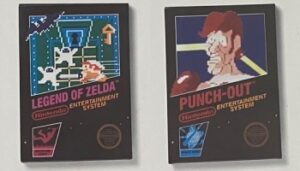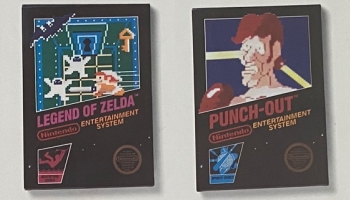 Like with any creative endeavor, actually completing development of a video game is only half the battle. The other half involves getting eyeballs in front of your completed game and getting these new fans to (hopefully) tell their friends all about it.
Like with any creative endeavor, actually completing development of a video game is only half the battle. The other half involves getting eyeballs in front of your completed game and getting these new fans to (hopefully) tell their friends all about it.
Game publishers have tried lots of different marketing methods over the years, and we look at two of them in this edition of Bite-Sized Game History, as well as what happens when you need to pitch your game to the most famous film director in the world.
![]() You can find a lot of dedicated video game historians on Twitter, and in 280 characters or less, they always manage to unearth some amazing artifacts. Bite-Sized Game History aims to collect some of the best stuff I find on the social media platform.
You can find a lot of dedicated video game historians on Twitter, and in 280 characters or less, they always manage to unearth some amazing artifacts. Bite-Sized Game History aims to collect some of the best stuff I find on the social media platform.
Nintendo made a lot of deliberate moves to position the Nintendo Entertainment System as a high-end gadget instead of a children’s toy when they introduced the console to North America in 1985. Ditching the childish red-and-white styling used for the Famicom was probably the most famous change, but shipping each “game pak” in eye-catching black boxes was another way they attempted to distinguish the NES from the Atari 2600.
After briefly swapping the black for silver and experimenting with hand-drawn artwork, Nintendo had completely phased out the black box template just ahead of the 1987 launch of the second wave of major NES releases. At the forefront of this changeover were two huge titles that were the first to break from the convention.
But would The Legend of Zelda have captivated an entire generation of gamers without its iconic gold packaging? And could Punch-Out!! have KOed the competition without Mike Tyson on the cover? Thanks to a recent post from Martin Lindell, an Advisor to the Embracer Games Archive, we got a peek at what this alternate past might have looked like.
In this rare promotional flyer from WCES 1987, it appears that Nintendo initially designed packaging for The Legend of Zelda and Punch-Out!! (which had not yet added Tyson as the game’s final boss) using the black box template:
Nice seeing these old early versions of packfronts for Zelda and Punch Out. pic.twitter.com/TUBWYHc0bi
— Martin Lindell (@martinlindell) October 8, 2022
It’s been more than five years since the 2017 launch of Marvel Vs Capcom Infinite, so naturally, rumors have begun to swirl about what fans might expect to see in the next entry in the crossover fighting franchise. But before the series can move forward, let’s take a look back at Marvel Vs Capcom Origins, a compilation that was originally released in 2012.
Andrew Schnorr was the Marketing Manager for the title, which brought together 1995’s Marvel Super Heroes and 1998’s Marvel Vs Capcom: Clash of Super Heroes, and he made great use of the built-in nostalgia fans have for all things Capcom and Marvel in creating a promotional push for the game. That included a playful parody of Rob Liefeld’s signature art style for the box art, as well as Tribute Artwork that mixed and matched Capcom and Marvel characters over the decades, along with a series of really creative trailers and videos:
Today is the 10th anniversary of the launch of Marvel vs Capcom Origins (Sept. 25, 2012). This was a pretty minor release (2012 Capcom had a lot of heavy hitters, good and bad), but damned if it's not one of my top 3 favorite marketing campaigns. So here's a fun retrospective ?! pic.twitter.com/gB4WGxH1UL
— Andrew Schnorr (@elderlyapple) September 25, 2022
Whether you’re talking about the books, the movies, or the games, the Jurassic Park franchise is fairly consistent in not being consistent, and the original Jurassic Park is one of the few entries to… ahem… knock it out of the park in every format. The difficulty in creating a sequel to Jurassic Park was obvious right away, as even Michael Crichton was initially hesitant to pen a followup to his massive bestseller. Though Crichton was unsure where the story should go next, Steven Spielberg’s blockbuster film adaptation of Jurassic Park provided some inspiration, and he conquered his writer’s block to deliver The Lost World to bookstores in 1995.
In the decades since that first sequel, a wide variety of new voices have added additional stories and spinoffs to the dino-disaster saga.
One of those voices belonged to Seamus Blackley, one of the architects of the original Xbox. In 1997, Blackley was working for DreamWorks Interactive as one of the lead developers on Jurassic Park: Trespasser, a game that would serve as a direct continuation to the film adaptation of The Lost World. After several delays, Trespasser launched a year later to poor sales and even worse reviews. The team’s vision for a “hyper-realistic” first person shooter fell quite a bit short, though it would inspire a legion of other developers as one of the first games to incorporate a full physics engine.
More than a decade later, Blackley found himself back in Spielberg’s orbit in 2012. The famed director had always dabbled in game development, and he asked Blackley if he would be interested in creating a sequel to Trespasser. Work on the sequel, which was known as Jurassic World, began right away, but a change in Universal Studios’s leadership lead to its quick cancellation.
Though as you might have guessed by its title, Jurassic World got a happy ending. Blackley’s proposal was forwarded to producer Frank Marshall, who reworked parts of it into the recently-concluded Jurassic World film trilogy. You can hear more about this story (and watch the pitch trailer that Blackley personally screened for Spielberg) in this thread:
In 2012 or, I left my job at CAA to work with Steven S on a game, a new Jurassic Park story, to make good the skid mark we left with Trespasser. I wrote a story and design, and made a trailer. The management at Universal changed, and the project became a film. Want to know more?
— Seamus Blackley (@SeamusBlackley) July 23, 2022
Thanks to Martin Lindell, Andrew Schnorr, and Seamus Blackley for these stories from the game development trenches. If you’d like to go spelunking with me for more bits of Bite-Sized Game History, please be sure and follow me on Twitter.

